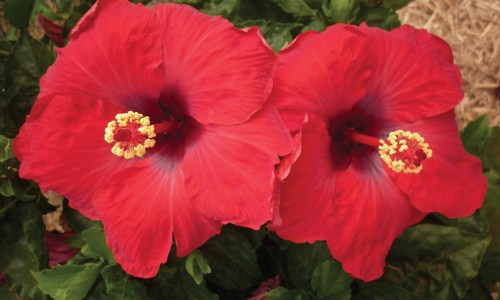From vibrant rubies and lemon yellows to bright oranges and stunning pinks, the hypnotic hibiscus will transform any garden into a tropical oasis. Here are the top tips for growing your own.
Grow your own hibiscus
People often ask me: What is your favourite flower? With more than 391,000 species of plants in the world, it’s a difficult question. For me, there are dozens of favourites, but there is one that always comes out on top: hibiscus.
Although we associate hibiscus with the islands of Hawaii, many of the hibiscus we see in southern Australia originated in the more temperate regions of China and Southeast Asia and the tropical islands of southern Africa. These woody plants possess stunning flowers in simple colours.

As early botanists started to travel extensively in the 1700s, southern Africa became an important port as explorers and botanists explored the fauna and flora of the world. The spectacular hibiscus captivated the Europeans who took seeds back to the northern hemisphere where hybridising and cross pollinating began. A few simple original species have been developed into thousands with the bright and beautiful colours and habits that we see today.
Although just eight species of hibiscus were originally identified, most are now grouped (sometimes incorrectly) into the more temperate Asian variety hibiscus sinensis. The plants commonly available in Adelaide garden centres in summer and autumn are easy to grow in our climate, tolerating hot summers, cool winters and long periods of dry weather. Areas of heavy frosts should be avoided.

Adaptable to most soil types, they can be found growing in soils of beachside suburbs through to the heavy clay of the Adelaide plains. These tend to be more of the simple colours, from reds through to pinks and whites, in single and double form that are vigorous growers.
A sunny position is a must. Prepare the soil with well-rotted manure and keep the plants well mulched in hot weather – cool roots are important. General garden watering is suitable, especially in the growth stage, but ease back a little towards flowering as this will aid a heavy flowering period. Hibiscus love fertiliser and will take whatever you can provide, gobbling it up in spring for healthy green growth and from mid-summer to early winter for flowers.

The best time for planting is late spring through summer. This is when you will find the largest selection at your local garden centre. Pruning is best in early spring after the threat of frost has passed and warm weather is present. No specific pruning skills are required and a light trim is usually all that’s needed. A very heavy prune will be required if plants are too large or need regenerating. Pruning into old wood may seem harsh, but hibiscus will respond with fresh new growth within weeks.
Hibiscus sinensis varieties are ideal for hedging, screening, windbreaks or as a statement feature plant. They are commonly standardised or can easily be espaliered to cover a fence or a wall. Most varieties easily reach two to three metres between five and 10 years. I would recommend varieties such as Winter Show, Enid Lewis or Appleblossom if you like pink; Andersonii or Sabrina if you like reds; and Mrs Andresean, Wilders White or White Kalakua if you are looking for creams or whites.

The large, multi-coloured hibiscus flowers we commonly associate with tropical areas of the world are bundled under the label “Hawaiian Hibiscus”. These are generally single flowering varieties of which you can now get every colour of the rainbow, even blue. Sourcing the most unusual colours can be difficult but collectors and some specialist nurseries are where the greatest treasures can be found.
These are less vigorous varieties and most grow only to about one metre tall in Adelaide. They require rich soil, regular summer watering and protection from strong or cold winds and flower best in 25 to 30 degrees Celsius, so late summer through autumn is when the best flowering can be expected. The spectacular blooms will be reward for a little extra attention and are best in a pot or special place in the garden.

My favourite varieties include Bali Sunset which has a huge single orange flower the size of a dinner plate. Pirates Patch with its enormous flowers that are white in summer with a raspberry eye and a blush pink in autumn. And Grapette: a very unusual grey/blue colour.
The more readily available compact varieties are the Rio Clara series. Bred in Europe for ease of growing, compact habit and free flowering, these beauties come in a range of tropical colours and grow easily in Adelaide. Varieties in this series grow between 60cm to 120cm high, making them a low maintenance and useful alternative. Or consider the stunning pink Shabby Chic, or the fiery orange Peach Melba.

As many Adelaide gardens are becoming smaller, and perhaps a little shadier, a tropical garden is a great year-round option with splashes of bright hibiscus flowers dotted through the sunnier spots. Rio Clara Series varieties can be planted in between other foliage plants and will pop through with a happy splash of colour – perfect around pools and courtyards.
With hibiscus flowering in such a wide colour palette, there is one for every situation. But throw colour schemes out the window with hibiscus as they are such a treasured treat that suit anywhere.

From mid-summer to late autumn, my favourite time in the garden is spent with my collection of Hibiscus. Every day a new colour and a new flower appears, taking me back to a tropical island, with the waves licking at my feet and a glass in hand.



